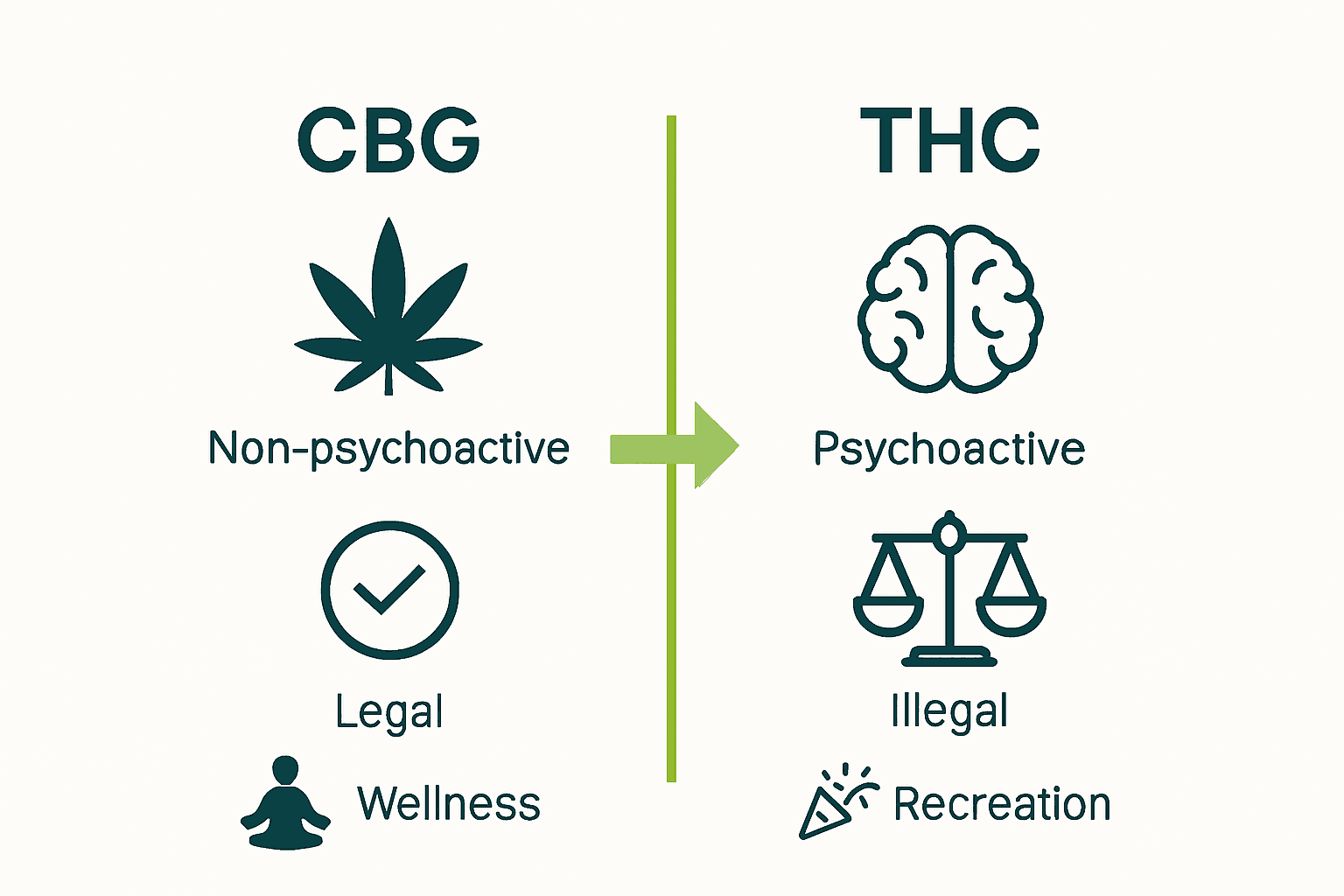Did you know that cannabis contains over 100 unique cannabinoids, each with its own distinct effects on the body and mind? While THC is famous for the high it produces, CBG is drawing attention for offering wellness benefits without intoxication. Understanding these two compounds is key for anyone interested in the potential of cannabis. Unlock how their different roles could shape your health decisions and everyday life.
Table of Contents
- CBG And THC Defined: Core Concepts
- Differences In Effects And Mechanisms
- Legal Status Of CBG And THC In The U.S.
- Practical Uses: Wellness, Recreation, And More
- Potential Risks And Common Misconceptions
Key Takeaways
| Point | Details |
|---|---|
| Psychoactivity | THC is psychoactive and produces euphoric effects, while CBG is non-psychoactive and supports wellness without cognitive impairment. |
| Legal Status | THC is heavily regulated and varies by state, whereas CBG is generally legal if hemp-derived, with fewer restrictions. |
| Therapeutic Potential | CBG is being researched for potential therapeutic benefits, differentiating it from THC, which is primarily used for recreational purposes. |
| Safety Awareness | Responsible consumption is essential, as THC can impair cognitive functions, and there are quality control concerns with cannabinoid products, including CBG. |
CBG and THC Defined: Core Concepts
Cannabis is a complex plant containing over 100 unique compounds called cannabinoids, with two standout molecules capturing significant attention: THC and CBG. According to the Centers for Disease Control, THC remains the primary psychoactive component responsible for the characteristic ‘high’ associated with cannabis consumption.
Tetrahydrocannabinol (THC) represents the most well-known cannabinoid, famous for its mind-altering properties. It directly interacts with the brain’s cannabinoid receptors, producing euphoric and intoxicating effects. When consumed, THC binds to receptors in the central nervous system, triggering psychological and physiological changes that can include relaxation, altered perception, and increased appetite.
In contrast, Cannabigerol (CBG) emerges as a fascinating non-psychoactive cannabinoid often referred to as the ‘mother cannabinoid’. While THC creates noticeable mental shifts, CBG operates more subtly. As a precursor molecule, CBG actually serves as the biochemical foundation from which other cannabinoids are synthesized. This means that during cannabis plant growth, CBG naturally transforms into compounds like THC and CBD through complex enzymatic processes.
Key differences between THC and CBG include their effects and interaction with the human endocannabinoid system.
 Beyond THC: Why Minor Cannabinoids Like CBG and CBN Deserve the Spotlight highlights that while THC produces intoxication, CBG potentially offers alternative wellness benefits without cognitive impairment. Researchers continue exploring CBG’s potential therapeutic applications, making it an increasingly intriguing compound in cannabis science.
Beyond THC: Why Minor Cannabinoids Like CBG and CBN Deserve the Spotlight highlights that while THC produces intoxication, CBG potentially offers alternative wellness benefits without cognitive impairment. Researchers continue exploring CBG’s potential therapeutic applications, making it an increasingly intriguing compound in cannabis science.
Here’s a comparison of the key differences between THC and CBG:
| Aspect | THC | CBG |
|---|---|---|
| Psychoactivity | Yes, intoxicating | No, non-intoxicating |
| Primary Receptor | CB1 (partial agonist) | CB1, CB2 (modulator) |
| Main Effects | Euphoria Relaxation Altered perception |
Subtle wellness support No mental alteration |
| Legal Status (U.S.) | Strictly regulated Varies by state |
Generally legal if hemp-derived |
| Typical Uses | Recreation Mood elevation |
Wellness Potential therapeutic use |
| Safety Considerations | Cognitive impairment Legal risks |
Fewer psychoactive risks Quality control concerns |
Differences in Effects and Mechanisms
The neurological and physiological interactions of THC and CBG with the human body reveal fascinating distinctions in their mechanisms of action. According to Cannabis Evidence, THC functions as a partial agonist at CB1 receptors, which primarily explains its profound psychoactive effects and ability to generate the characteristic cannabis ‘high’.
When THC binds to cannabinoid receptors, it triggers a cascade of neurochemical responses that dramatically alter perception, mood, and cognitive function. These interactions can produce effects like euphoria, relaxation, altered sensory perception, and increased appetite. In contrast, CBG demonstrates a fundamentally different engagement with the endocannabinoid system, operating without the intoxicating properties associated with THC.
Research from the National Institutes of Health indicates that THC acts as a partial agonist at both CB1 and CB2 receptors, contributing to its complex psychoactive profile. This dual-receptor interaction explains why THC can simultaneously produce psychological changes and influence physiological processes like pain perception and immune system responses. Understanding the Difference Between CBG and CBD further illuminates how CBG operates more subtly, potentially offering therapeutic benefits without cognitive disruption.
The key distinguishing factor lies in receptor interaction and subsequent neurological impact. While THC directly stimulates receptors and creates pronounced mental alterations, CBG appears to modulate receptor activity more gently. This nuanced difference suggests CBG might have significant potential in wellness applications, offering potential therapeutic benefits without the intoxicating effects that make THC controversial. Researchers continue exploring these intricate molecular interactions, uncovering how different cannabinoids uniquely influence human physiology.
Legal Status of CBG and THC in the U.S.
The legal landscape surrounding cannabinoids is complex and continually evolving. University of Michigan Health notes that the 2018 Farm Bill dramatically transformed cannabis regulation by removing hemp from the federal Controlled Substances Act, effectively legalizing cannabinoids like CBG derived from hemp. However, this federal guidance does not create a uniform legal environment across all states.
THC remains more strictly regulated due to its psychoactive properties. While hemp-derived THC products with less than 0.3% Delta-9 THC are federally permissible, individual states maintain significant discretion in establishing their own cannabis regulations. This means the legal status of THC can vary dramatically from one state to another, creating a patchwork of regulations that consumers must carefully navigate. Cannabis Regulatory Overview provides comprehensive insights into these nuanced state-level distinctions.
CBG, being a non-psychoactive cannabinoid, generally encounters fewer legal restrictions compared to THC. Most states view CBG more favorably, particularly when derived from hemp and containing minimal THC content. However, consumers should remain vigilant, as regulatory interpretations can change rapidly. Factors such as source of extraction, THC percentage, and specific state laws can significantly impact the legal standing of CBG products.
For cannabis enthusiasts and wellness seekers, understanding these legal nuances is crucial. While federal legislation has opened doors for hemp-derived cannabinoids, responsible consumption requires staying informed about current state regulations. Consulting local legal resources and keeping abreast of evolving cannabis laws remains the most prudent approach to enjoying CBG and THC products within legal boundaries.

Practical Uses: Wellness, Recreation, and More
The Centers for Disease Control highlights that cannabis can be consumed through various methods, including smoking, vaping, and edibles, with effects varying based on THC concentration and consumption approach. While THC is often associated with recreational use, both THC and CBG offer intriguing potential for wellness and personal enhancement.
Recreationally, THC remains the primary cannabinoid for those seeking mood elevation and sensory experiences. Its psychoactive properties make it popular among individuals looking to unwind, enhance social interactions, or explore altered states of consciousness. Understanding Cannabis for Relaxation provides deeper insights into how cannabis can facilitate stress relief and mental recalibration.
CBG, by contrast, emerges as a wellness-focused cannabinoid. University of Michigan Health notes the growing interest in hemp-derived cannabinoids for potential health benefits. While not FDA-approved, CBG is increasingly incorporated into wellness routines, with enthusiasts exploring its potential for supporting physical comfort, mental clarity, and overall balance. Why Try CBG-Infused Drinks for Wellness offers a comprehensive look at integrating CBG into holistic lifestyle practices.
Ultimately, the choice between THC and CBG depends on individual goals. Whether seeking recreational enjoyment, stress management, or wellness optimization, these cannabinoids offer nuanced experiences. Responsible consumption, understanding personal tolerance, and staying informed about legal and health considerations remain paramount in exploring the diverse world of cannabis compounds.
Potential Risks and Common Misconceptions
The Centers for Disease Control warns that cannabis use can potentially lead to significant health risks, particularly impacting cognitive functions like memory, attention, and learning. These risks are especially pronounced for young people and pregnant individuals, challenging the misconception that cannabinoids are universally safe for all demographics.
One prevalent misconception surrounds the perceived uniformity of cannabinoids. While CBG is often marketed as a ‘safer’ alternative, University of Michigan Health highlights critical concerns about the lack of regulatory oversight. The absence of stringent quality control means that cannabinoid products may contain hidden contaminants or exhibit inconsistent potency, potentially exposing consumers to unintended health risks.
THC carries particularly nuanced risks due to its psychoactive properties. Unlike CBG, THC can induce temporary cognitive impairment, affecting judgment, motor coordination, and reaction times. This makes activities like driving extremely dangerous when under its influence. The notion that cannabis use has no consequences is dangerously misleading, and responsible consumption requires understanding individual tolerance and potential side effects.
Ultimately, education remains the most powerful tool in navigating cannabinoid use. Consumers should approach these compounds with informed caution, recognizing that individual responses can vary dramatically. Consulting healthcare professionals, understanding personal health history, and purchasing from reputable sources are critical steps in mitigating potential risks associated with THC and CBG consumption.
Explore the Benefits of CBG and THC for Your Wellness Journey
Understanding the clear differences between CBG and THC helps you make informed choices that align with your wellness and lifestyle goals. Whether you are looking for the non-intoxicating benefits of CBG or the recreational effects of THC, it is important to find high-quality hemp-derived products that match your needs. Both cannabinoids offer unique experiences with varying effects on your mind and body that can support relaxation, clarity, or mood enhancement.
Ready to experience these benefits for yourself? Discover our carefully curated selection of premium products designed to fit your preferences. From soothing CBG options crafted for wellness to vibrant THC varieties that ignite your senses, 23state.com has you covered with quality and care.

Start your journey toward enhanced balance and enjoyment today by browsing our collections. Visit 23state.com now and take advantage of exclusive offers and free shipping designed to give you the very best in hemp-derived cannabis products.
Frequently Asked Questions
What are the main differences between CBG and THC?
CBG (Cannabigerol) is a non-psychoactive cannabinoid that offers subtle wellness support, while THC (Tetrahydrocannabinol) is psychoactive and produces a ‘high.’ CBG serves as a precursor to other cannabinoids like THC and CBD, whereas THC interacts directly with CB1 receptors, leading to significant psychological effects.
Can CBG and THC be used together for enhanced effects?
Yes, CBG and THC can be used together, as some users explore the combination for a more balanced experience. While THC provides intoxicating effects, CBG may offer wellness benefits without the mental alterations that THC induces.
What are the common uses of CBG?
CBG is primarily focused on wellness, with potential therapeutic applications such as supporting physical comfort, enhancing mental clarity, and promoting overall balance. It is increasingly incorporated into wellness routines despite not being FDA-approved.
Are there any risks associated with using THC or CBG?
Yes, THC can lead to cognitive impairment, affecting memory and coordination, which poses risks during activities such as driving. CBG, while generally considered safer, may still pose health risks due to the lack of regulatory oversight in product quality and potency.

